Wc - types and features
Each owner of the house or apartment, performing repairs in the toilet, trying to install a stylish and comfortable toilet. Today, there is a huge selection of models on the market, among which the most demanded is, perhaps, a floor-mounted toilet.
In this article we will learn about the design features and types of this sanitary device.
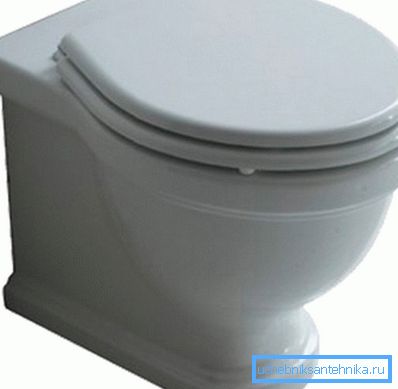
Features added flaws
Attached toilets are installed on the floor, close to the wall, hence the name. In fact, this design is a symbiosis of a traditional and suspended innovative toilet.
The main feature of this solution is that it allows you to hide:
- Siphon bends;
- Cistern;
- Sewerage and water supply system;
- Drain pipes.
Note! Communications can be hidden not only in the wall, but also in a special cabinet. Special cabinets for side WCs can be purchased at plumbing stores.
Moreover, in contrast to the suspended models, in this case, installation of an expensive installation is not required, since communication can be hidden behind any false panel made, for example, from drywall.
It should be noted that the additional type of toilet is considered the most functional, thanks to excellent hygienic indicators and other features. In particular, its use is the best solution for small rooms.
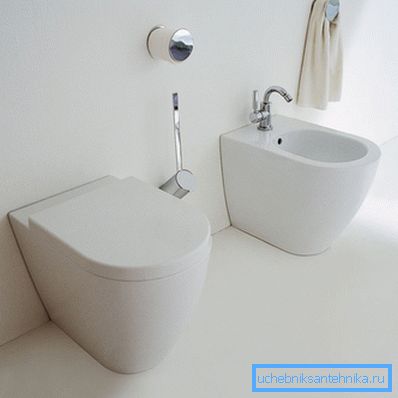
Merits
In addition to the above advantages, the design under consideration also has other positive aspects:
- It saves space as this product is shorter than a traditional compact.
- The relative ease of installation, so that most home craftsmen can install it with their own hands.
- Toilet design can be done flawless.
- Hidden tank for side toilet allows you to visually expand the space.
For these reasons, this plumbing is so popular among consumers.
Tip! For a more compact placement of plumbing, you can use a corner toilet.
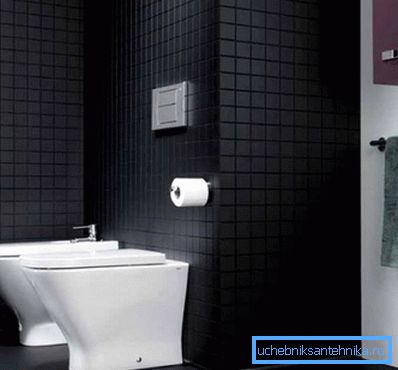
disadvantages
Along with positive qualities, this sanitary equipment has some disadvantages, which are listed below:
- Higher price than traditional toilet.
- Difficulty in maintenance and repair, as all communications are hidden behind a false wall.
- The inconvenience of replacing or repairing the tank fittings, as it is also hidden behind the panel.
In general, we can say that these shortcomings are not significant.
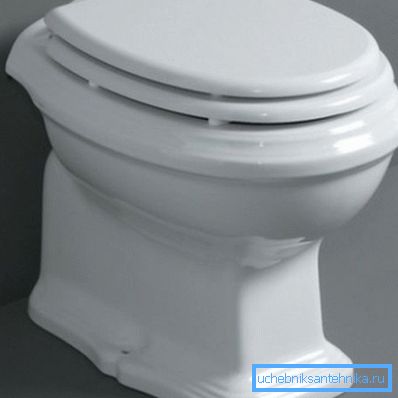
Types of WCs
Despite the fact that all models of side-mounted toilet bowls have a common construction, they have some differences, which consist in the following points:
- The material from which they are made;
- Type of release;
- Type and organization of the drain.
Below we take a closer look at all these differences of this plumbing.
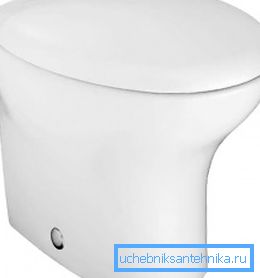
Materials
Like traditional toilet bowls, the products in question are most often made from the following materials:
| Faience | It is the most popular material, since it is cheaper than porcelain, while beautiful and has good performance. |
| Porcelain | It is resistant to mechanical and chemical stress. Due to the fact that porcelain does not absorb unpleasant odors and moisture, it is easy to clean. |
| Stainless steel | These products are easy to clean, and bacteria do not develop on their surface. The main distinctive feature is high resistance to mechanical loads. |
| Composite | Products differ in variety of color scale as various additives imitating the texture of a natural stone and other surfaces are mixed with the main polymer concrete. |
| A natural stone | Products are the most beautiful, durable and at the same time the most expensive. |

Release form
Choose plumbing is necessary not only in appearance, but also compatibility with sewer pipes. Currently, manufacturers of toilet bowls produce products with three types of release:
| Kosim | The branch pipe is located behind the base or bowl. The axis is located in relation to the floor at an angle of 45 degrees. |
| Direct | The horizontal pipe is parallel to the floor. This release is used for flush mounting in the wall. |
| Vertical | The additional toilet with vertical release is suitable for Soviet "Stalinok" and private houses. Its exit is located under the toilet and is directed straight to the floor. |
Note! Installation instructions added toilet bowls requires the use of extremely rigid connections, the connection of which is carried out using a sealant.
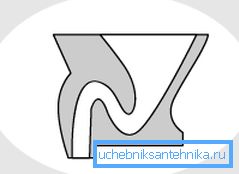
Types of drainage organization
In contrast to the traditional toilet, the attachment does not have the usual flushing cistern, as the water tank is mounted in the wall. As a rule, the flush-mounted flush tank for a side toilet has a flat shape and is located in the thickness of the wall or niches equipped there.
In this case, the drain system can be implemented in several ways:
| Showers | Water flows are distributed around the perimeter of the sanitary device. Flushing the contents of the bowl is carried out by a whirlpool. |
| Cascade | In this case, the water flows are evenly distributed and wash the contents of the bowl. Such a drain is less effective. |
| Suction | It is the most effective. Its meaning is to fill the bowl with water, which carries with it the contents of the bowl when the drain valve is opened. |
As a rule, additional toilet bowls are sold with a hidden cistern in the kit, however, this sanitary equipment can also be found on sale separately.
Here, in fact, all the main features and types of additional toilet bowls that you need to know when choosing plumbing.
Conclusion
A toilet with an installation allows, first of all, saving space in the bathroom and beautifully decorating this room. After all, thanks to the ability to hide the tank and communications behind the wall, this solution looks modern and stylish.
From the video in this article you can get some additional information on this topic.